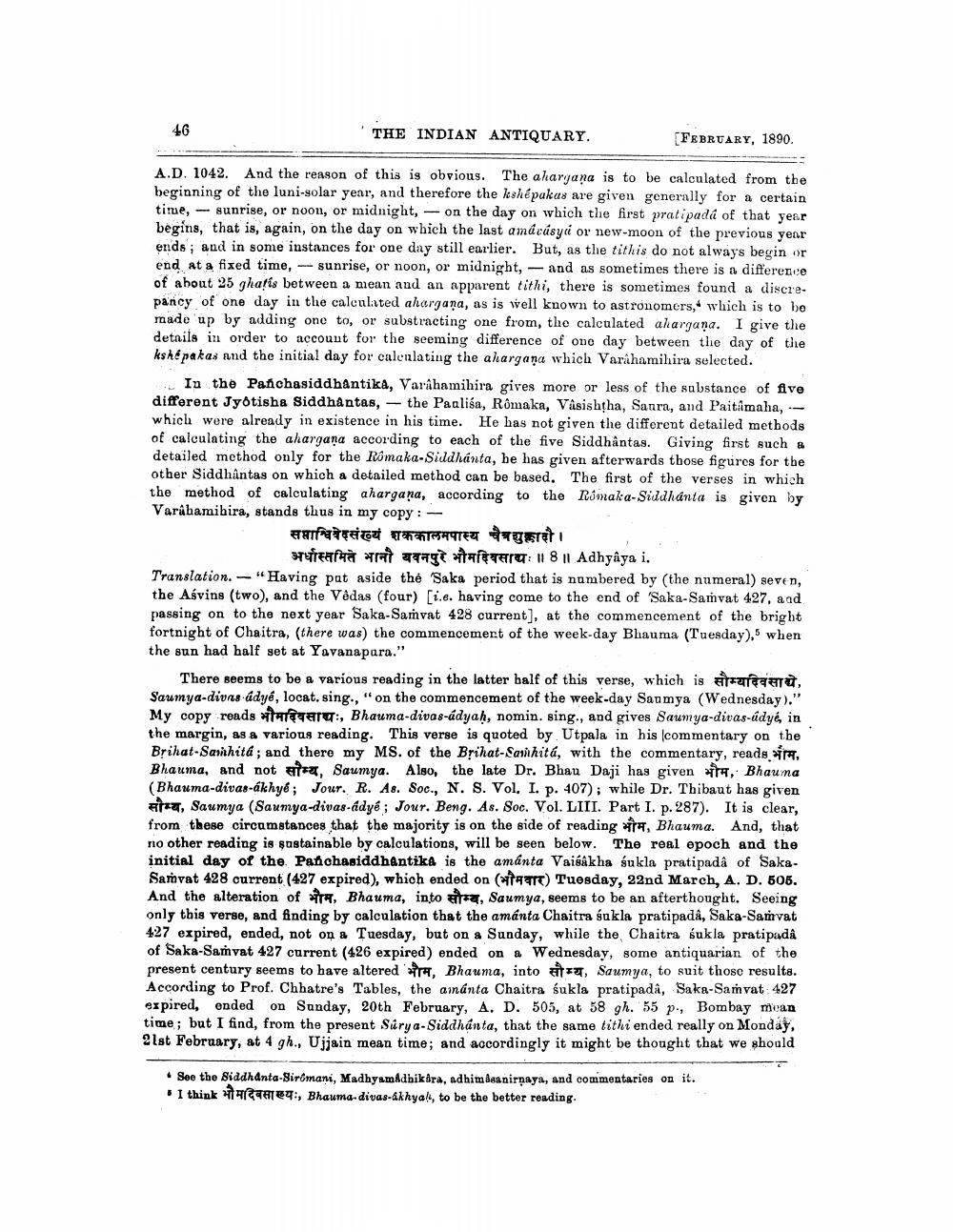________________
46
THE INDIAN ANTIQUARY.
FEBRUARY, 1890.
A.D. 1042. And the reason of this is obvious. The aharyana is to be calculated from the beginning of the luni-solar year, and therefore the kshépukas are given generally for a certain time, - sunrise, or noon, or midnight, - on the day on which the first pratipadá of that year begins, that is, again, on the day on which the last amácúsyo or new-moon of the previous year ends; and in some instances for one day still earlier. But, as the tithis do not always begin or end at a fixed time, - sunrise, or noon, or midnight, - and as sometimes there is a difference of about 25 ghatis between a mean and an apparent tithi, there is sometimes found a discre. pancy of one day in the calculated ahargana, as is well known to astronomers, which is to be made up by adding one to, or substracting one from, the calculated ahargana. I give the details in order to account for the seeming difference of one day between the day of the kshé pakas and the initial day for caleulating the ahargana which Varahamihira selected.
In the Panchasiddhantika, Varahamihira gives more or less of the substance of five different Jyotisha Siddhantas, - the Paaliśa, Rômaka, Vásishtha, Sanra, and Paitamaha, - which were already in existence in his time. He has not given the different detailed methods of calculating the ahargana according to each of the five Siddhantas. Giving first such & detailed method only for the Rômaka-Siddhanta, be has given afterwards those figures for the other Siddhậntas on which a detailed method can be based. The first of the verses in which the method of calculating ahargana, according to the Romaka-Siddhanta is given by Varahamihira, stands thus in my copy :
सप्ताश्विवेदसंख्यं शककालमपास्य चैत्रशुक्लारी।
strah ra ang Tag: 11 8 11 Adhyâya i. Translation. - "Having pat aside thé Saka period that is numbered by (the numeral) seven, the Asvins (two), and the Vedas (four) [i.e. having come to the end of Saka-Samvat 427, and passing on to the next year Saka-Samvat 428 current], at the commencement of the bright fortnight of Chaitra, (there was) the commencemert of the week-day Bhauma (Tuesday), when the sun had half set at Yavanapara."
There seems to be a various reading in the latter balf of this verse, which is grazredad, Saumya-divas adyé, locat. sing., "on the commencement of the week-day Saumya (Wednesday)." My copy reads Tag:, Bhauma-divas-ádyah, nomin. sing., and gives Saumya-divas-údyé, in the margin, as a various reading. This verse is quoted by Utpala in his commentary on the Brihat-Sarihita; and there my MS. of the Bţihat-Sarithita, with the commentary, readsra, Bhauma, and not jaz, Saumya. Also, the late Dr. Bhau Daji has given 14, Bhau ma (Bhauma-divas-akhye; Jour. R. As. Soc., N. S. Vol. I. p. 407); while Dr. Thibaut has given Araz, Saumya (Saumya-divas-adyé; Jour. Beng. As. Soc. Vol. LIII. Part I. p. 287). It is clear, from these circumstances that the majority is on the side of reading , Bhauma. And, that no other reading is sustainable by calculations, will be seen below. The real epoch and the initial day of the Panchasiddhantika is the amanta Vaisakha sukla pratipadâ of SakaSamvat 428 current (427 expired), which ended on (ATT) Tuesday, 22nd March, A. D. 505. And the alteration of *, Bhauma, into ty, Saumya, seems to be an afterthought. Seeing only this verse, and finding by calculation that the amanta Chaitra sukla pratipadâ, Saka-Samvat 427 expired, ended, not on Tuesday, but on a Sunday, while the Chaitra sukla pratipada of Saka-Samvat 427 current (426 expired) ended on a Wednesday, some antiquarian of the present century seems to have altered A, Bhauma, into atz, Saumya, to suit those results. According to Prof. Chhatre's Tables, the amánta Chaitra sukla pratipada, Saka-Samvat 427 expired, ended on Sunday, 20th February, A. D. 505, at 58 gh. 55 p., Bombay moan time; but I find, from the present Súrya-Siddhanta, that the same tithi ended really on Monday, 21st February, at 4 gh., Ujjain mean time; and accordingly it might be thought that we should
• Soe the Biddhanta-Siromani, Madhyamidbikára, adhimdaanirnaya, and commentaries on it. . I think ITF34:, Bhauma-divas-akhyal, to be the better reading.




